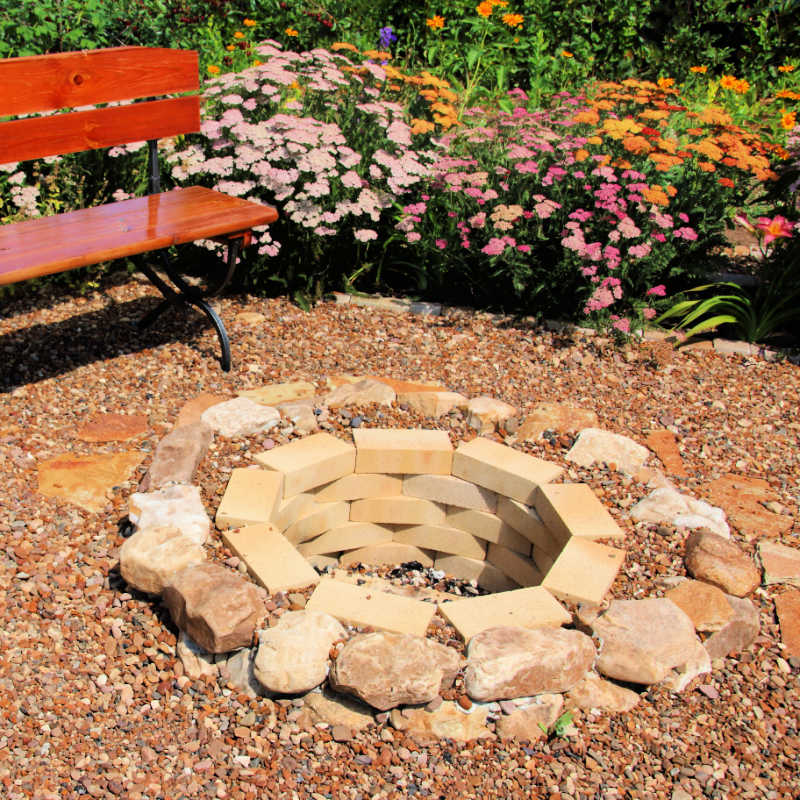
Fire Pit Stones and Bricks: A DIY Guide
Table of Contents
Creating a DIY fire pit in your backyard is an excellent way to elevate your outdoor space, providing warmth, ambiance, and a place to gather with friends and family. To build a durable and attractive fire pit, selecting the right materials is essential. In this comprehensive guide, we'll explore the various types of fire pit stones and bricks, along with some tips and tricks for constructing your DIY fire pit.
Types of Fire Pit Stones | Bricks

Natural stones are popular choices for DIY fire pits due to their durability and heat resistance. These stones would be used on the outer of the fire pit area, and tend to be aesthetically pleasing. They are not recommended for use on the inner most area facting the fire directly! Some common types of fire pit stones include:
-
Sandstone:
A sedimentary rock that offers a rustic look and can withstand high temperatures. Sandstone is available in various colors, including red, brown, and gray. -
Limestone:
Another sedimentary rock, limestone is known for its light-colored appearance and natural elegance. It is a sturdy material that can handle extreme heat. However, using limestone as the interior brick (closest to the fire) is not recommended as it can expand and potentially explode. -
Granite:
An igneous rock that is extremely durable and heat-resistant, granite offers a more polished look for your fire pit. Its speckled appearance adds character to any outdoor space. -
House Bricks | Concrete Bricks | Cinder Blocks:
These types of bricks are very common and can be easy to source and use. Quite often they are already available to the user. However, these should never be used to line the inner, fire facing area of the fire pit, and only be used on the exterior brick work.
Can you use bricks such as house bricks for a fire pit? Can you use regular bricks for a fire pit?
You can use regular bricks for the outside of your fire pit but you should not use them for the inner section that faces the fire directly! You need specialised fire bricks as outlined below!
Fire Bricks and Heat-Resistant Mortar

Fire bricks, also known as refractory bricks, are a unique type of brick made from fire clay and are highly resistant to extreme temperatures. They are commonly utilized in kilns, furnace linings, fireplaces, and fireboxes. Fire bricks are manufactured similarly to standard bricks, but they undergo a burning process during which they are subjected to exceptionally high temperatures. Most firebricks can withstand up to 980 ºC (1800 ºF).
Fire bricks are essential for lining the inner walls of your fire pit. They are made from refractory ceramic materials that can handle high temperatures without cracking or deteriorating. When assembling your fire pit, be sure to use heat-resistant mortar to secure the fire bricks and other stones. This type of mortar is specifically designed for high-temperature applications and will ensure the longevity and stability of your fire pit.
Another aspect of these fire bricks is they will withstand the dramatic changes in temperatures and won't crack when going from extreme hot to cold. They will withstand icy conditions to intense heat when using your fire pit in winter!
Are bricks safe for a fire pit?
You can use house fire bricks or regular bricks for the outside of your fire pit but you should not use them for the inner section that faces the fire directly! You need specialised fire bricks as outlined above. Some bricks such as limestone may explode or expand rapidly if used and can be dangerous.
Are there alternative materials instead of fire bricks?
You can use alternative materials such as red clay bricks, refractory concrete, or even a special sandstone called ankar sandstone. Ankar sandstone also has a beautiful and unique light jade colour in some versions. On the other hand red clay bricks tend to be cheap and may be sourced for free from renovations where you can have them if you collect them from the site (check local classifieds, you never know!)
Design and Construction Tips
When designing your fire pit, consider the size, shape, and layout that will best suit your outdoor space. Circular and square fire pits are popular options, but don't be afraid to get creative with your design.
When constructing the fire pit, dig a shallow trench and lay a gravel base to promote proper drainage. Then, build the outer walls using your chosen fire pit stones, securing them with heat-resistant mortar. Finally, line the inner walls with fire bricks, also using heat-resistant mortar.
Other Use Cases for Fire bricks
Fire bricks are not just used in fire pits. Quite often they are used in BBQ grills, especially in outdoor built in units. either the area directly around the unit is lined with the fire bricks or the fire bricks are built into the unit. Check out this extensive DIY outdoor BBQ area that uses a fire brick lined Parrilla Charcoal grill.

Additional Accessories and Considerations
To enhance your fire pit experience, consider adding a grill grate or a spit attachment for cooking. These accessories transform your fire pit into a versatile outdoor cooking space, perfect for barbecues and gatherings. Additionally, always be mindful of local regulations and safety precautions when building and using your fire pit. Maintain a safe distance from structures and flammable materials, and never leave a fire unattended.
➡ Our full range of Fire Pits we have for sale
With the right fire pit stones, bricks, and construction techniques, you can create a stunning and functional DIY fire pit that will become the centerpiece of your outdoor living space. For more detailed information, step-by-step guides, and design inspiration, explore our extensive resources on fire pits in our Ultimate Fire Pit Guide.



Leave a comment